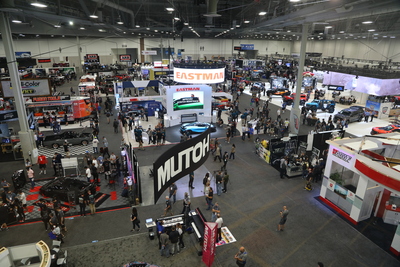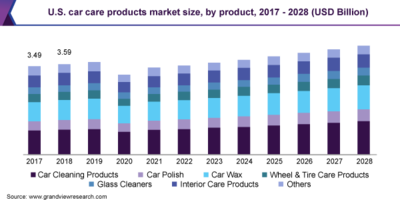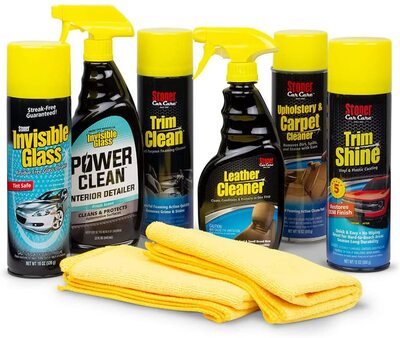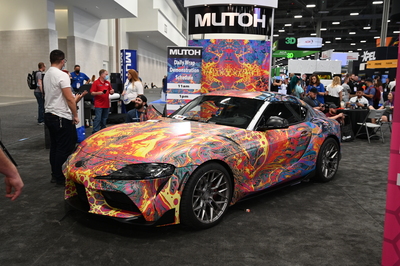BUSINESS
2022 Car-Care and Restyling Market Trends
Space-Age Tech and Retro Styling: An Ever-Diversifying Industry
By Douglas McColloch

For the 2021 SEMA Show, the Car Care & Restyling section was relocated to the all-new West Hall at the Las Vegas Convention Center. Dozens of companies exhibited their latest offerings with product demonstrations throughout Show week.
For builders, car-care and restyling products are an essential tool for customization and maintenance. They can provide upgrades to OE paint, glass and chrome. They can dress up an interior or refine an exterior, often at a reasonable cost. And they’re available in a wide range of parts, applications and price points, offering useful products and services to nearly any enthusiast.
The segment was a bright spot during the pandemic. The market registered double-digit point-of-sales gains in 2020 over 2019, with pickup accessories leading the way. For 2021, the market saw steady if not spectacular growth. By itself, the car-care treatment segment represents a $1.86 billion market, according to the “2021 SEMA Market Report.” Considering that many products in the category are relatively inexpensive and can be installed or applied without the need of special tools or training, it’s likely that enthusiasts sheltering at home took advantage of extra downtime to treat their vehicles to some sprucing up.
We contacted several industry experts for this article. The following is a compilation of their insights and observations on the current state of the market and its outlook going forward, edited for clarity and length.
Trends & Products: What’s Moving The Market

After seeing a decline in sales in 2020, car-care products bounced back in 2021, and global sales are projected to increase at a 4.3% compound annual growth rate through 2028. (Source: Grandview Research)
A recent study by market research firm Grand View Research valued the global car-care market at $11.23 billion in 2021, with a forecast to grow at a compound annual growth rate of 4.3% from 2021 to 2028. The biggest sales drivers in the segment were car cleaning products and waxes. According to the report, growth is attributable to increased global auto sales, an expected rise in consumer incomes, and innovations in car-care product development.
“The state of the car-care industry is incredible right now,” said Michael Pennington, director of training, events and consumer relations for Meguiar’s. “Through COVID, we’ve seen a huge growth in the category as people stayed at home and had more time to work on their projects.”
“The overall state of the restyling industry is very healthy,” said Cristina Jorge, vice president of Specialty Automotive Treatments. “There was a rough patch with inventory in 2020, so those restylers with wholesale businesses who sold direct to retailers suffered a bit. From what I’m hearing, though, retail business has been going up, and a lot of restylers who used to sell 80/20 wholesale/retail are now doing 50/50.”
Nick Griot, executive vice president of product development and brand for Griot’s Garage, agreed in general while adding a mild caveat: “Worldwide cost increases are touching nearly every part of our market, in particular raw materials and increased transit costs of sourced components. This will invariably lead to price increases that may bring demand back down to earth.”
He added that most companies will probably still see growth as more consumers own their cars longer and do more to preserve them.
David Korvah, marketing manager for Avery Dennison Graphics Solutions, expressed similar caution. Due to a variety of external factors, he said, “People who normally would be spending on auto restyling may be holding off more now than they have in the past six years.”
Many of the products most favored by consumers in recent years continued to exert a strong pull in 2022. Herrington said that there are two distinct paths in car care.
“The first is ‘quick and easy,’” he said. “That covers your spray detailers and interior spray products for people whose vehicles are in good shape and who don’t spend an excessive amount of time keeping them looking good.
“The second path is new technology—specifically ceramic coatings. The technology has been around 15 years or so for professional detailers and installers, but it started to enter the DIY market around three years ago. Now, people who can’t afford to pay $1,000 or $2,000 to apply a coating want to take advantage of the Si02 technology and apply it themselves.
“Think ‘car waxes.’ The first generation was carnauba. Then came polymers in the ’80s and ’90s, and now we’re in the ceramic realm where you get even better protection and better longevity. The people who use these products want the latest technology and the best protection, and they’re willing to pay good money for it, so they’re kind of the opposite of the ‘fast and easy’ demographic.”
Jorge said that vinyl wrapping is something she’s seen quite a bit over the last few years.
“I also see ceramic coating really starting to take off now, particularly in terms of consumer awareness,” she said. “My customers in general would never typically ask for that, but I have people asking for it by name now.”
Ceramic coating applicators are also faring well.
“The large-scale adaptation of machine polishing as a prerequisite for superior ceramic results has helped the polisher market grow at an explosive rate,” Griot said. “Our purpose-built machine polishers have done very well as a result of this shift to ceramic surface protection.”
“Strong areas [in restyling] include paint protection film, wrapping film and window tint,” Korvah said. “We’re also seeing more shops doing both vehicle graphics and window film. Those used to be separate specialties.”
An increase in purpose-built vehicles has likewise increased interest in idiosyncratic styling applications—in a word, “retro,” said Courtney Pahlke, owner of Top Coverage Ltd.
“With a lot of Jeep and truck builds over the past few years, we’ve noticed a lot of retro color schemes and wheel packages,” she said. “Now, with the new Bronco appealing to the ‘retro’ market, we’re seeing even more of it, so I think we’ll see a lot of ’80s and ’90s grunge-type colors in the future.”
Consumer Outreach in the Post-Pandemic Age

All-in-one car-care and detailing kits such as this package from Stoner Car Care exert a strong appeal, since they don’t require buyers to spend extra time hunting for various products from multiple sources. Instead, it’s all in one bundle.
With shelter-in-place orders came increased consumer reliance on digital (i.e., online) shopping resources, and with that also came the need for companies to reinvent the way they market themselves to the public.
“Social media is huge right now,” Pennington said. “For a company like ours that’s been around for five generations with a big audience to reach, we look at a variety of avenues, including TV, print and even radio as well as social media, and we look at each platform and try to make sure we’re delivering the right message to that specific audience.
“We had to make a pivot during the pandemic. With a lot of car shows being locked down and all of the in-person training we had to discontinue, we had to turn really quickly to webinars, so we built a brand-new studio and started producing live videos on a variety of platforms.”
“Social media is extremely important,” Jorge concurred. “I don’t think that many of us as restylers use it as well as we could sometimes. I think we could learn a lot from some of the car guys who are in the restyling industry who use social media a lot better than many of us do. It’s really important for establishing that connection to your customers—particularly dealer customers.”
“People in the restyling market are very tech-savvy,” Korvah noted. “They’re fast adopters of social media as channels to share their latest creations and grow their client base. The restyling market is a tight-knit community, and social media especially allows us the opportunity to connect and engage with this community—and we learn from our installers too.”
Griot emphasized the educational value of social media.
“We put a lot of effort into our educational efforts, generally through video form,” he said. “That may be a YouTube video explaining a process or even a Live Broadcast via YouTube that allows for a long-form deep dive into specific processes and immediate, real-time interactions with our customers.”
Social media continues to evolve at a rapid pace, and companies need to constantly stay abreast of the latest user trends, Jorge noted.
“Instagram is great, and Facebook is great, but then you start to see a generational shift where the younger generation likes TikTok or Snapchat, so there’s always something that you have to keep up with,” she said.
Digital marketing can also be leveraged to increase efficiency and drive sales.
“Restylers are really focused on digital marketing direct with dealerships right now so we can get our product to the client before the car is even purchased,” Jorge added.
The COVID disruption also gave restylers the extra time they might have needed to hone their business skills.
“We opened a new location during COVID,” Pahlke said. “We utilized the extra time with our dealer reps, while dealerships had the time, to train everybody on product knowledge so when they’re filling that one vehicle, they know everything on the different trim levels. You can’t necessarily get the items that you want—it might take eight months for you to get the exterior color you want—so we’re training people to add accessories to increase profit and to save the customers money.”
Challenges and Opportunities

While not quite as prevalent as they were a few years ago, vinyl wraps such as this example at the Mutoh booth at the 2021 SEMA Show are still popular, as they allow vehicle owners to apply a personal protective touch to their vehicles at a user-friendly price.
Our panel of experts pointed to a number of short-term challenges that companies in the segment are likely to face in the near future, and supply-chain issues were near the top of everyone’s list.
“They’re a huge challenge right now,” Jorge said. “One of the biggest challenges we [restylers] face is the growing consumer trend of buying cars online. When consumers buy vehicles directly online, they just look up a stock number at a dealership, contact the dealer, and then walk in and take delivery. The opportunity for accessories now has to shift more toward resale, for restylers to sell direct to consumers.”
One challenge facing the car-care market is the need to confront lingering public perceptions that have built up around the industry over decades.
“There’s a lot of noise out there between the manufacturers, distributors, retailers and consumers—and with the internet, everyone’s an expert,” Pennington said. “For us, one of the biggest challenges is simply shattering a lot of myths. When I started out in this business, you had a lot of ‘miracle cures’ that didn’t deliver what they promised, and that turned off a lot of consumers. If we can break that pattern of thinking, we can get consumers to understand that car care can be easy with a premium brand. If you’re working too hard, you’re using the wrong products.”
The current relative scarcity of new vehicles on dealer lots may inhibit consumer spending on other items.
“Consumers are overspending on cars because prices are so ridiculously high,” Jorge noted. “What’s going to happen four years from now when you go to return that lease or try to sell that car? You’re going to be underwater because you don’t have enough equity in it—and I think that’s going to affect spending in general.”
Another problem is accessory inventory.
“Dealers aren’t keeping a 90-day supply,” Pahlke said. “They’re keeping maybe a 30-day supply, if that, and they’ve realized that it’s more profitable for their business model now.”

Ceramic coatings such as this paint coating from Gliptone have been one of the hottest tickets in car-care products in recent years. They’re easy to apply and provide the ultimate in long-term protection from the elements.
Darrell Reed, commercial director for Eastman Performance Films, also pointed to a shortage of qualified installers as a current challenge.
“The automotive films market has experienced constraints across the entire value chain, creating a need for more agility and transparency,” Reed said. “We’ve seen the industry adjust accordingly. Strong communication with resources and customers has also become paramount, and it now gets more focus than ever before. Additionally, post-pandemic shifts in workforce needs have encouraged the industry to reexamine organization design and how to better meet the needs of talent for better retention.”
Inflation remains a pressing concern as well.
“The industry’s biggest risk is undoubtedly the inflationary environment we find ourselves in and how that impacts the consumer’s discretionary spending,” Griot said. “Appearance chemicals are very much a discretionary expense, even though a car’s value can be improved with routine maintenance of its appearance. With cost pressures coming from everywhere, prices will have to rise as well, potentially creating an even larger incentive for consumers to spend their dollars on other essentials.”
Still, an inflationary market could yield unexpected bonuses.
“This situation presents opportunities for everyone throughout the value chain to potentially reset their customer mix and improve margins on what might end up being fewer installations,” Griot said.
Despite the many challenges, our experts saw opportunities for growth, though most expected a slowdown from early pandemic levels when the specialty-equipment market gained millions of new customers. Korvah remained optimistic.
“We expect to watch the restyling market grow and develop by expanding its offerings,” he said. “And we also expect consumers to continue personalizing and protecting their vehicles in the future.”

Retro restyling cues are coming back in vogue, and the “Tacozilla” Tacoma camper that exhibited at the Toyota booth at the 2021 SEMA Show was a case in point. It looks like a mid-’80s factory graphics package, but it’s actually a custom paint application.
“Growth is always going to be around, as long as you let people know that car care is easy,” Pennington said. “Once you show people how much better their car can look—and it’s easy to do when you use the right products—they get excited. It’s just simple education.
“People love to take care of their cars, whether in good times or challenging times. The products are affordable, and people can do it themselves. Sometimes, spending time working on your vehicle in your garage takes you away from reality for a little while and puts you in a happy place.”
Griot concurred.
“If times get tougher, people will be seeking relief in their hobbies,” he said. “We’re going to continue to be a fun outlet that helps people check out for a bit, and we believe that is something we communicate incredibly well.”
“We may be slowing down a little bit, but we think we’ll still see positive growth,” Pennington concluded. “Once you fall in love with your car, you never stop loving it.”






